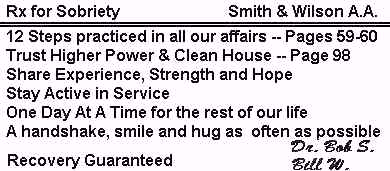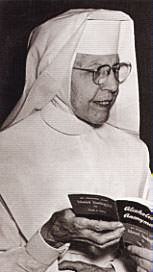

 Click The Images To Go To Page Indicated SISTER IGNATIA AND ALCOHOLICS ANONYMOUS
1889 - 1966 Sisters of Charity of St. Augustine The Drunk's "Angel of Hope" People who know the history of Alcoholics Anonymous have heard of Dr. Bob Smith and Bill Wilson, credited with founding the organization, but few have heard of the woman who shaped the hospital concept used to this day. On August 16, 1935, Sister Ignatia Gavin, a frail but no-nonsense Catholic sister in charge of admissions at St. Thomas Hospital in Akron, Ohio, with the help of Dr. Bob Smith, one of the founders of Alcoholics Anonymous, admitted the first alcoholic patient under the diagnosis of acute gastritis, thus making St. Thomas Hospital the first hospital in the world to treat alcoholism as a medical condition. Dr. Bob provided the medical treatment, while a steady stream of "reformed" alcoholics helped the man with his "spiritual" needs. Although the hospital did not want to admit alcoholics, Sister Ignatia had previously circumvented the system. Sister Ignatia's care for alcoholics started back in 1934, when she and emergency room intern, Thomas Scuderi, M.D., began secretly sobering alcoholics at the hospital, housing the alcoholism patient in the hospital's flower room. Sister Ignatia increasingly began to believe that alcoholics should not be sneaked into the hospital but brought through the front door just like other sick people. This belief led to the first medical admission in 1935. Soon, she provided a ward for men to sober up and St. Thomas Hospital became the first religious institution to recognize the rights of alcoholics to receive hospital treatment. Today, many of AA's practices -- including the use of tokens to mark milestones in sobriety -- find their origins with Sister Ignatia. Sister lgnatia was the first person to use medallions in Alcoholics Anonymous. She gave the drunks who were leaving St. Thomas after a five day dry out a Sacred Heart Medallion and instructed them that the acceptance of the medallion signified a commitment to God, to A.A. and to recovery and that if they were going to drink, they had a responsibility to return the medallion to her before drinking. Click to see Sacred Heart Medallion. The custom is carried out to this day with tokens awarded for sobriety. The sacred heart medallions had been used prior to A.A. by the Father Matthew Temperance Movement of the 1840's and the Pioneers, an Irish Temperance Movement of the 1890's. Dr. Bob died in 1950, and in 1952 Sister Ignatia was transferred to Cleveland's St. Vincent Charity Hospital. She recalled: "We're just like people in the Army, you know. We go where we are sent. . . . I was there [in Akron] for 24 years. . . and finally the obedience came that I was to go to Charity and work with AA there." On August 7, 1952, at age 63, the "Angel of Alcoholics Anonymous" arrived in Cleveland for her new assignment. Planning began for an alcoholism wing at the hospital. As part of the ward's setup, Sister Ignatia requested a coffee bar for the patients, similar to the one in Akron. However, a board member who reviewed the plan questioned the need for it. He returned the plan to Sister Ignatia and said, "A table will have to do." But. . . Ignatia would not compromise. She knew what she wanted for the AAs, and she put the future of the ward on the line with her reply: "Let's forget about it if you're not going to give us the proper setup." The coffee bar remained in the drawings. With the help and contributions of the many people Sister Ignatia had helped, Rosary Hall Solarium (its initials in memory of Dr. Bob, Robert Holbrook Smith) accepted its first patient on December 15. It was a kind of recovery mecca where physical medicine, spiritual nourishment, and brotherly love regularly produced miracles of recovery. . . . Sister Ignatia was Rosary Hall's breath and spirit. Through the years, the program successfully treated thousands of alcoholics. Sister Ignatia was among the first to acknowledge alcoholism among priests and nuns. She was also instrumental in implementing the first Al-Anon program, for families of alcoholics. Even as her health declined, Sister Ignatia continued to care for alcoholics at Rosary Hall. Thousands of alcoholics knew first-hand Sister Ignatia's honesty and nonjudgmental love. For more than 30 years, Sister Mary Ignatia Gavin, CSA, founding both Ignatia Hall at St. Thomas in Akron and Rosary Hall Solarium at St. Vincent, was a messenger of hope for alcoholics and their families. Her courageous stand for medical treatment and her caring devotion to the victims of alcoholism helped Dr. Bob Smith and Bill Wilson, founders of Alcoholics Anonymous, and thousands who have come after them. Sister Ignatia never accepted recognition for any of her work with alcoholics. Even in 1961, when she was recognized for her work by President Kennedy, gracious humility prevailed, accepting the awards only in the name of her religious community and profession. Sister Ignatia retired in May 1965. She died less than a year later on April 1, 1966. The following article, which appeared in a Roman Catholic publication, THE SIGN, Vol. 35: 9-11, May 1956, may give a wrong impression that A.A. is a Christian, if not Roman Catholic, organization, which will be spotted quickly by most A.A. members who read it. True, A.A.'s roots were in a Christian organization, the Oxford Groups. And true, most of the people treated by Sister Ignatia were Christians, and most probably became better Christians as a result of practicing the A.A. program. But Catholics became better Catholics, Protestants better Protestants, Jews better Jews, as a result of working the 12 Step program. Sister Ignatia urged us, "Be a better whatever you are today."
SISTER IGNATIA AND ALCOHOLICS ANONYMOUS The telephone rang and Sister Ignatia answered it. "This is Bill, Sister. I'm sorry, but I'm going to have to send you back the Sacred Heart Badge. I've had a rough morning and I'm going out to get a drink. Sister Ignatia sighed, but said quickly: "Don't do it, Bill. Wait until you finish work at five. Then call me again. In the meantime, I'll pray for you. Whatever you do, don't send me back that badge. Keep it with you for strength and inspiration." Sister Ignatia prayed hard all afternoon and, finally the call came from Bill. "It's O.K., Sister, I never took the drink. I think I'm going to be all right now, thanks to the Sacred Heart and you." The telephone calls and the information conveyed were nothing new -- it happens quite often. For Sister Ignatia is founder and director of Rosary Hall Solarium, an alcoholic ward at St. Vincent Hospital in Cleveland, Ohio. Since December 1952, she has ministered to the needs of some 3,000 men and women who have succumbed to alcoholism. Of that total, some 60 per cent are claimed as completely cured; another 20 percent stumble for a while and then go off drink completely; and only 20 percent are considered failures after the spiritual and therapeutic treatment. And when they leave Rosary Hall, Sister Ignatia gives them a Sacred Heart Badge. It is meant as a constant source of inspiration not to take another drink. And she tells them all that the badge is given only on the understanding that it must be returned before the first drink is taken. Working among alcoholics has been a life's labor of love for Sister Ignatia. She has been credited in large measure with pushing the creation of Alcoholics Anonymous. Certainly, she was in at the beginning when the late Dr. Robert H. Smith of Akron and Bill W., New York stockbroker, founded A.A. in 1935. At that time, Sister Ignatia was stationed in St. Thomas Hospital, which also is operated by her order, the Sisters of Charity of St. Augustine. Dr. Smith, although not a Catholic, was on the courtesy staff of the hospital. He had, himself, just conquered the drink habit and felt the need to help others in a similar plight. He enlisted the aid of Sister Ignatia. Dr. Smith and Sister Ignatia agreed on one thing -- alcoholism could be controlled by medical attention coupled with spiritual attention. It was on this principle that they eventually established at St. Thomas, Akron, a ward which dealt exclusively with persons suffering from alcoholism. It was the first such effort in the country. Dr. Smith died in 1950 and Sister Ignatia later went to Cleveland Charity Hospital. The name Rosary Hall Solarium came about because permission to erect the Cleveland ward came on the feast of the Holy Rosary and because the initials of the A.A. co-founder were RHS. What goes on at Rosary Hall? Backbone of the program is the famous "Twelve Steps" of the A.A. Basically, this involves an admission by the victim that he is powerless to help himself, followed by a decision to turn his will and life over to the care of God. Rosary Hall has its own chapel where patients pray the Rosary every day at 3 P.M., invoking God's help and that of Our Lady of Perpetual Help, patroness of alcoholics. To gain access to Rosary Hall, a person must be sponsored by a member of Alcoholics Anonymous in good standing. He must have the desire not only to get sober but also to remain sober. The patient's five-day stay is a retreat from the outside world and the habits which caused his collapse. There are no radios, TV sets, newspapers, or magazines -- nothing but A.A. literature and other reading in keeping with the program. The physical therapy used is the most modern known to medical science. Doctors as well as priests are essential on the road to recovery. Patients may have no visitors except members of A.A. who are welcome from 9 A.M. till 9 P.M. The conversation is turned to alcoholism and its problems. Every evening a member of A.A. comes to conduct a brief meeting for patients. An essential element of Rosary Hall is its coffee bar, open all the time. There is also a kitchen and an icebox well stocked with food. Main items are milk and citrus juice, for the alcoholic is frequently an undernourished person. The patients are encouraged to eat at will. Rosary Hall's program has restored many alcoholics to useful and happy lives. It is essentially a spiritual program, demanding humility and constant prayer for God's help. Charity is involved, too, because A.A.'s, once they stop drinking, devote much of their time to helping others who are in the plight from which they were rescued. In Rosary Hall, all the rooms but one are for more than one patient, because it is not good for an A.A., usually, to be alone. There is one private room for difficult cases in the worst stages. Sister Ignatia calls it the "defrosting room." Rosary Hall was fitted out by A.A.'s. As soon as the project was initiated they swarmed in and took the details out of Sister Ignatia's hands. "Just let us worry about that," became the repeated injunction to her. A.A.'s with all kinds of occupations volunteered their services. Catholics, Protestants, and Jews -- they all sent money or contributed labor. Sometimes they broke down as they recalled their own decline and how Sister Ignatia and others had helped them out. One businessman who dropped in conferred with other A.A.'s and then departed to arrange for some furnishings. Sister Ignatia inquired anxiously whether he had quoted a price. She lifted her hands helplessly when told: "There is no price. He's donating everything." After that, all sister could say was: "Well that's the A.A. for you. They're all like that. And their relatives and friends are like that. Really, I haven't anything to do with all this. It's Our Lady and the A.A.s who are doing it." Sister Ignatia is a very shy woman, frail, almost transparent. Yet she is firm and resolute, and energetic to the point where twenty-four hours is a short day. Her much sought after anonymity was shattered early in 1954, when she was awarded the Catherine of Siena Medal by the Theta Pi Alpha Sorority of National Catholic Women's Colleges. She was honored for "outstanding achievement in one of our major problems affecting our country today -- alcoholism." The medal is given annually to a Catholic woman who has made a distinctive contribution to Catholic life in the U.S. Sister Ignatia has certainly done that -- and for years. She won't talk much about it, but her Rosary Hall project is a means of conversions for the many non-Catholic who enter its portals. It also resulted in many lapsed Catholics returning to the Sacraments after years of negligence. Many invalid marriages have been righted and, as a result, entire families have entered the Church. Rosary Hall also offers its services for the many harmed by alcoholics. A very alert and thriving group of women composed of wives and relatives of members of Alcoholics Anonymous meet each week to discuss their problems. The objective is the rebuilding of their marriages and the re-christianizing of their homes and families. It has resulted in an unusually intelligent approach to the solution of the problems. The women pool their experiences and encourage one another to have faith in their spouses and to aid them on the road to spiritual and material contentment. It has been mentioned that not all the patients are men. The women who stay at Rosary Hall are hospitalized in a special room, two are admitted at a time. The problems are the same for these patients and the road to recovery just as strenuous. However, like their male counterparts, they mostly make it. One thing though -- there are no second chances at Rosary Hall. Patients are admitted once. If they fail then, some other method has to be devised to try and straighten them out. But there is no talk of failure on the part of Sister Ignatia. These men and women come to her at their lowest ebb. In most cases it is her consolation that they rise above their degradation and assume their true dignity as sons and daughters of God. This is the way she expressed it all: "I am just one of those many women of the Catholic nursing community of America who are striving to rescue men and women from the bottomless pit of alcoholism. "Universities and welfare groups have expended millions of dollars in an attempt to find the causes of alcoholism. Yet, no one has been able to place his or her finger upon the exact cause. However, it is the consensus of opinion among great minds who have attacked the problem that a lack of proper spiritual application on the part of the victim is at least a primary cause. "The co-founders of Alcoholics Anonymous believed that the solution of the problem for many was to be found in the merger of forces of medicine and religion. With this union, what could be more conducive to the regeneration of the whole person than the atmosphere of a Catholic hospital? The professional, medical case administered within its precincts affords spiritual, physical, mental, and moral therapy. "Alcoholism strikes at men and women in all walks of life. Surveys show that 25 percent of the "Skid Row" population in any large city possess university degrees. The fruit of the vine -- a harmless stimulant for many -- in the hands of the alcoholic turns to poison." "The alcoholic is deserving of sympathy. Christlike charity and intelligent care are needed so that with God's grace he or she may be given the opportunity to accept a new philosophy of life." Sister Ignatia has special names for each of the five days a patient spends at Rosary Hall. They are: Day of Reception; Day of Realization; Day of Moral Inventory; Day of Resolution; and Day of Plans for the Future. As he leaves Rosary Hall, the recovering patient must then face his own problem. The way has been paved by the A.A. sponsor. The future is in God's hands. He has learned to say, "O, God, grant me the serenity to accept things I cannot change, courage to change the things I can, and wisdom to know the difference." The patient is urged to guard against pride, self-pity, resentment, intolerance, and criticism; to attend meetings, spread the principles of Alcoholics Anonymous, and to return to the hospital to help others. Finally, there is the Sacred Heart Badge. Not many are returned to Sister Ignatia. But when they are, she pleads for the patient not to take the first step on the return to ruin. Very often it means a long distance phone call, a fervent prayer, and the help of a local A.A. group to keep the tempted on the right path. To alcoholics all over America, Sister Ignatia is called "Little Angel." She is indeed small and frail, but her strength is that of a Michael and her message that of Gabriel. Both the humble and the great who "died" in drink and became "new" again will attest to that. Index of AA History Pages on Barefoot's Domain As in so many things, especially with we alcoholics, our History is our Greatest Asset!.. We each arrived at the doors of AA with an intensive and lengthy "History of Things That Do Not Work" .. Today, In AA and In Recovery, Our History has added an intensive and lengthy "History of Things That DO Work!!" and We will not regret the past nor wish to shut the door on it!!
KEEP COMING BACK!
On the Web Feb 1, 2002 in the Spirit of Cooperation Three mighty important things, Pardn'r, LOVE And PEACE and SOBRIETY |


